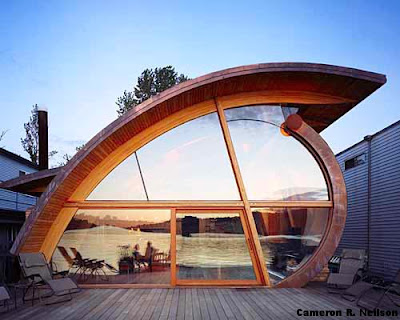SIEEB – Sino-Italian Energy Efficient Building
 SIEEB – Sino-Italian Energy Efficient Building – was been presented on December 7th 2004 in Beijing
SIEEB – Sino-Italian Energy Efficient Building – was been presented on December 7th 2004 in BeijingSIEEB project is regarded as a platform to develop the bilateral long-term cooperation in the environment and energy fields and a model case for showing the CO2 emission reduction potential in the building sector in China.
This building will be realized in the Tsinghua University Campus in Beijing and has been designed by arch. Mario Cucinella and Politecninco of Milano .
It is a 20.000 m2 building, 40 m high and it will host a Sino-Italy education, training and research centre for environment protection and energy conservation. This integrated design process is a most distinctive part of the project and a key issue for green buildings.
The building is therefore generated through a series of testing and computer simulations of its performance in relation to its possible shape, orientation, envelope, technological systems and so on. The building is designed to find a balance among energy efficiency targets, minimum CO2 emissions, a functional layout and the image of a contemporary building.
· resources saving including construction materials and water;
· minimization of environmental impact in both the construction and in-use stages;
· intelligent control during operation and maintenance;
· healthy indoor air;
· environmentally sound and durable materials;
· water recycling and re-use.
The SIEEB building shape derives from the analysis of the site and of the specific climatic conditions of the Beijing. Located in a dense urban context, surrounded by some high-rise buildings, the building optimises the need for solar energy in winter and for solar protection in summer.
Reflecting and semi-reflecting lamellas and louvers will also allow for sunshine to penetrate in the rooms in winter and to be rejected in summer, reducing the energy consumption of the building.
Double Façade and artificial lighting will be based on high efficiency lamps and fittings, controlled by a dimming system capable to adjust the lamps power to the actual local lighting needs, in combination with the natural light contribution. A presence control system will switch off lights in empty rooms.
Thermal comfort conditions are provided by a primary air (distributed by means of a displacement ventilation system) + radiant ceiling system. This combination minimises electricity consumption in pumps and fans. Lightweight radiant ceilings allow for lower air temperature in winter and higher in summer, thus reducing energy consumption; moreover, the presence sensors, coupled with CO2 sensors, can modulate either the air flow and the ceiling temperature when few or no people are in the room, thus avoiding useless energy consumption. In summer night cooling takes place.
Gas engines are the core of the energy system of the building. They are coupled to electric generators to produce most of the electricity required. The engines waste heat is used for heating in winter, for cooling – by means of absorbtion chillers – in summer and for hot water production all year round.
A sophisticated, “intelligent” control system manages the plant.
Because of the cleaner electricity produced, the amount of CO2 emissions per square meter of the SIEEB will be far lower than in present Chinese commercial building stock.
From Architect Mario Cucinella


Comments